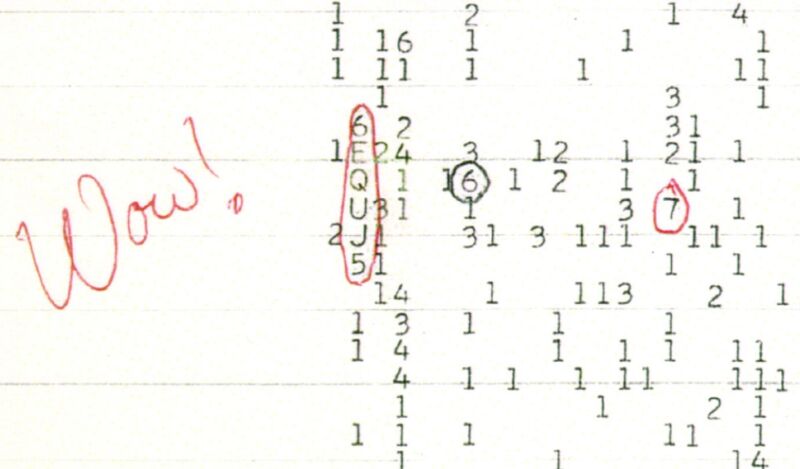
Public domain
An unusually bright burst of radio waves—dubbed the Wow! signal—discovered in the 1970s has baffled astronomers ever since, given the tantalizing possibility that it just might be from an alien civilization trying to communicate with us. A team of astronomers think they might have a better explanation, according to a preprint posted to the physics arXiv: clouds of atomic hydrogen that essentially act like a naturally occurring galactic maser, emitting a beam of intense microwave radiation when zapped by a flare from a passing magnetar.
As previously reported, the Wow! signal was detected on August 18, 1977, by The Ohio State University Radio Observatory, known as “Big Ear.” Astronomy professor Jerry Ehman was analyzing Big Ear data in the form of printouts that, to the untrained eye, looked like someone had simply smashed the number row of a typewriter with a preference for lower digits. Numbers and letters in the Big Ear data indicated, essentially, the intensity of the electromagnetic signal picked up by the telescope over time, starting at ones and moving up to letters in the double digits (A was 10, B was 11, and so on). Most of the page was covered in ones and twos, with a stray six or seven sprinkled in.
But that day, Ehman found an anomaly: 6EQUJ5 (sometimes misinterpreted as a message encoded in the radio signal). This signal had started out at an intensity of six—already an outlier on the page—climbed to E, then Q, peaked at U—the highest power signal Big Ear had ever seen—then decreased again. Ehman circled the sequence in red pen and wrote “Wow!” next to it. The signal appeared to be coming from the direction of the Sagittarius constellation, and the entire signal lasted for about 72 seconds. Alas, SETI researchers have never been able to detect the so-called “Wow! Signal” again, despite many tries with radio telescopes around the world.
One reason for the excited reaction is that such a signal had been proposed as a possible communication from extraterrestrial civilizations in a 1959 paper by Cornell University physicists Philip Morrison and Giuseppe Cocconi. Morrison and Cocconi thought that such a civilization might use the 1420 megahertz frequency naturally emitted by hydrogen, the universe’s most abundant element and, therefore, something an alien civilization would be familiar with. In fact, the Big Ear had been reassigned to the SETI project in 1973 specifically to hunt for possible signals. Ehman himself was quite skeptical of the “it could be aliens” hypothesis for several decades, although he admitted in a 2019 interview that “the Wow! signal certainly has the potential of being the first signal from extraterrestrial intelligence.”
Several other alternative hypotheses have been suggested. For instance, Antonio Paris suggested in 2016 that the signal may have come from the hydrogen cloud surrounding a pair of comets, 266P/Christensen and 335P/Gibbs. This was rejected by most astronomers, however, in part because comets don’t emit strongly at the relevant frequencies. Others have suggested the signal was the result of interference from satellites orbiting the Earth, or a signal from Earth reflected off a piece of space debris.
Space maser!
Astrobiologist Abel Mendez of the University of Puerto Rico at Arecibo and his co-authors think they have the strongest astrophysical explanation to date with their cosmic maser hypothesis. The team was actually hunting for habitable exoplanets using signals from red dwarf stars. In some of the last archival data collected at the Arecibo radio telescope (which collapsed in 2020), they noticed several signals that were remarkably similar to the Wow! signal in terms of frequency—just much less intense (bright).
Mendez admitted to Science News that he had always viewed the Wow! signal as just a fluke—he certainly didn’t think it was aliens. But he realized that if the signals they were identifying had blazed brighter, even momentarily, they would be very much like the Wow! signal. As for the mechanism that caused such a brightening, Mendez et al. propose that a magnetar (a highly magnetic neutron star) passing behind a cloud of atomic hydrogen could have flared up with sufficient energy to produce stimulated emission in the form of a tightly focused beam of microwave radiation—a cosmic maser. (Masers are akin to lasers, except they emit microwave radiation rather than visible radiation.)
Proving their working hypothesis will be much more challenging, although there have been rare sightings of such naturally occurring masers from hydrogen molecules in space. But nobody has ever spotted an atomic hydrogen cloud with an associated maser, and that’s what would be needed to explain the intensity of the Wow! signal. That’s why other astronomers are opting for cautious skepticism. “A magnetar is going to produce [short] radio emissions as well. Do you really need this complicated maser stuff happening as well to explain the Wow! signal?” Michael Garrett of the University of Manchester told New Scientist. “Personally, I don’t think so. It just makes a complicated story even more complicated.”
arXiv, 2024. DOI: 10.48550/arXiv.2408.08513 (About DOIs).

